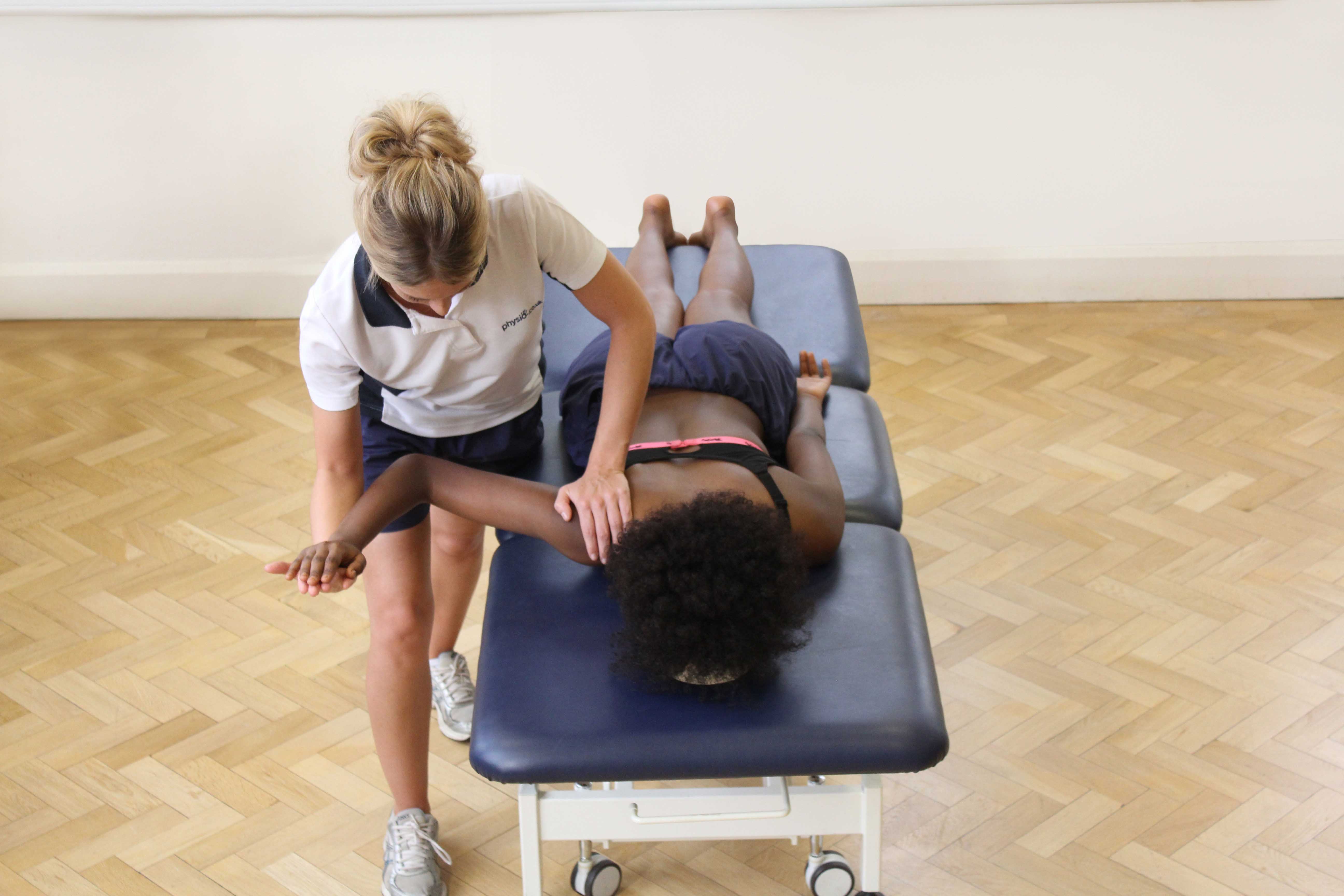What is shoulder instability?
Shoulder instability is when the capsule and ligaments supporting the shoulder joint become loose. Shoulder instability can be treated successfully with a programme of physiotherapy.
 Above: Shoulder toning exercises using tape to raise proprioceptive awareness
Above: Shoulder toning exercises using tape to raise proprioceptive awarenessHow does shoulder instability happen?
Shoulder instability occurs when the capsule and ligaments supporting the shoulder joint become loose and allow excessive movement of the joint. Shoulder instability is most common following a shoulder dislocation (where the top of the arm bone is ‘popped out’ of its socket). Dislocating the shoulder overstretches and injures the capsule and ligaments surrounding the shoulder joint. This reduces the ability of the capsule and ligaments to support the joint. This makes the joint ‘unstable’.
The capsule and ligaments supporting the shoulder joint may also be overstretched and damaged if they are repetitively stressed. This can occur during repeated throwing as the capsule and ligaments become loose and the shoulder joint becomes ‘unstable’. You can also have shoulder instability if you have naturally lax ligaments. People with this type of laxity are often referred to as ‘double jointed’ and have loose ligaments and instability in most joints in their body.
What are the symptoms of shoulder instability?
When the arm is placed in certain positions, the bones within the shoulder joint may slip or ‘subluxation’. This is a clunking sensation as the bones within the shoulder joint move excessively on one another. This clunking can sometimes cause a pain deep within the shoulder. This may cause you to avoid moving the arm into a position where it clunks. Some people also experience a ‘dead arm’ where the arm feels numb and weak for a few seconds after the bones slip or ‘subluxation’. If the capsule and ligaments supporting the shoulder joint are extremely loose, the shoulder joint may continually dislocate. Other symptoms of shoulder instability include:
What should I do if I have shoulder instability?
If you have or suspect you have shoulder instability, it is advised you seek the assistance of a physiotherapist as shoulder instability does not get better on its own.
 Above: Shoulder stretch and realignment exercises conducted by therapist
Above: Shoulder stretch and realignment exercises conducted by therapistPhysiotherapy treatment for shoulder instability.
Physiotherapy is very important in the treatment of shoulder instability. Initially, your physiotherapist can confirm your diagnosis and the extent of the damage. Following this, they will discuss how long your rehabilitation is expected to take and design a treatment programme specific to you. Physio.co.uk commonly use massage, stretches and a series of specific exercises designed to strengthen the muscles that stabilise and support the shoulder joint. Other physiotherapy treatments include: Surgery to reconstruct the damaged joint lining (‘labral tear’) and tighten the loose ligaments is sometimes necessary. The physiotherapists at Physio.co.uk can inform you whether and when this may be appropriate in your overall circumstances.
What shouldn’t I do if I have shoulder instability?
If you have or suspect you have shoulder instability, you should avoid those positions or activities that are likely to cause your shoulder to dislocate or ‘subluxation’. This may cause further damage and prolong your recovery.
Could there be any long-term effects from shoulder instability?
Shoulder instability generally does not produce any long-term effects if it is accurately diagnosed and treated. Treatment often involves several months of intense shoulder rehabilitation. This is usually successful; however, in some situations your instability may continue to be a problem. This may result in dislocation/s of the shoulder joint and, therefore, cause damage to the surrounding structures, including nerves, bone, and the cartilage lining the joint surfaces. Damage to the shoulder cartilage may result in shoulder arthritis later in life. To treat the ongoing laxity in the capsule and ligaments supporting the shoulder joint, surgery may be required to tighten these structures and increase the ‘stability’ of the joint.
To arrange a physiotherapy assessment call Physio.co.uk on 0330 088 7800 or book online today.

 0330 088 7800
0330 088 7800

































